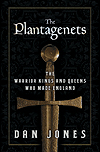
The Plantagenets: The Warrior Kings and Queens Who Made England, by Dan Jones, Viking, New York, 2013, $36
“What family doesn’t have its ups and downs?” ponders Eleanor of Aquitaine in James Goldman’s 1966 play The Lion in Winter. If she only knew! Eleanor was the wife of King Henry II (r. 1154-89), the first of the Plantagenet dynasty to rule England, as well as much of what is now France, for the next 250 years. Indeed, if one were to plot the fortunes of the succeeding generations of Plantagenet kings, the result would resemble something very like a sine curve.
The fortunes of the Tudors and Stuarts ran smoothly compared with those of the turbulent Plantagenets. Their story began with a shipwreck that drowned the only male heir to King Henry I, the last surviving son of William the Conqueror. When Henry died, England was subjected to a ruinous civil war over the succession that lasted nearly 20 years and from which emerged Henry II. Over the next 35 years Henry II, through a combination of military prowess, diplomatic statesmanship and seemingly inexhaustible effort, managed both to rebuild England and to establish a Continental empire to rival that of the Holy Roman emperors. Yet in only a few short years Henry’s last surviving son and heir, the disastrous King John, almost completely undid his father’s magnificent life’s work. At the time of his death John left England once again under the power of the rebellious Norman barons, and most of Henry’s continental holdings in the hands of King Philip II of France. For the next 200 years the history of the Plantagenets is traceable through a line of kings who seemingly alternated between strong and powerful nation-builders and their extremely weak and ineffectual successors.
Dan Jones’ book traces the history of that royal dynasty, beginning with the rise of Henry II in 1154. It concludes with the downfall of King Richard II in 1399, deposed by cousin Henry Bolingbroke who, as King Henry IV, established the new ruling house of Lancaster. The book recounts the sweeping story of the development of England from a primitive feudal society toward a modern nation. For all the despotic turbulence, it was the Plantagenet period that also witnessed the signing of the Magna Carta, the basis of modern British law, as well as the creation of Parliament, the basis of today’s British government.
Nevertheless, the central characters of the book are the Plantagenet kings who, regardless of their differing fortunes, all shared certain distinct family characteristics—namely pride, ambition, cruelty, greed and violent tempers. In fact, as the text reveals, hot tempers often seem to have proved their undoing.
The Plantagenets is a lively and entertaining retelling of the history of medieval England, although historians may argue the ruling family didn’t actually die out with Richard II. A case could be made that the succeeding houses of York and Lancaster, the members of which contended violently with each other over the crown during the 15th century, were nothing more than rival branches of the Plantagenet family. The Plantagenet connection of Henry Tudor, the usurper who eventually succeeded to the throne in 1485 as King Henry VII, was far more tenuous than that of the houses of either York or Lancaster, both of which had pretty much wiped each other out over three decades of civil war. All in all The Plantagenets is a must for those interested in medieval history or the history of the royal family.
—Robert Guttman




